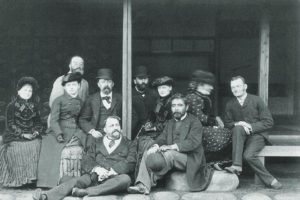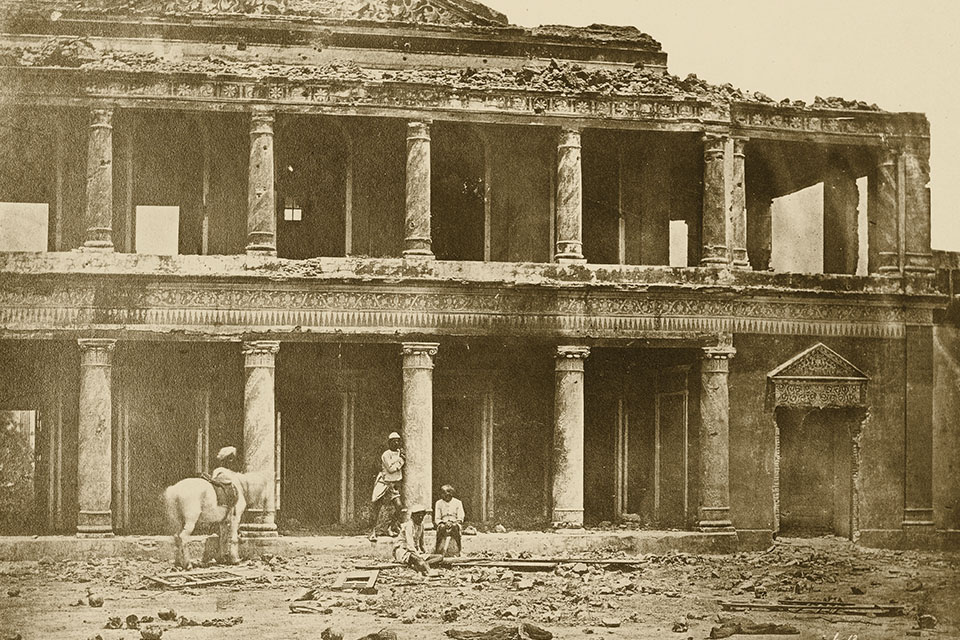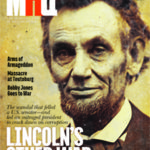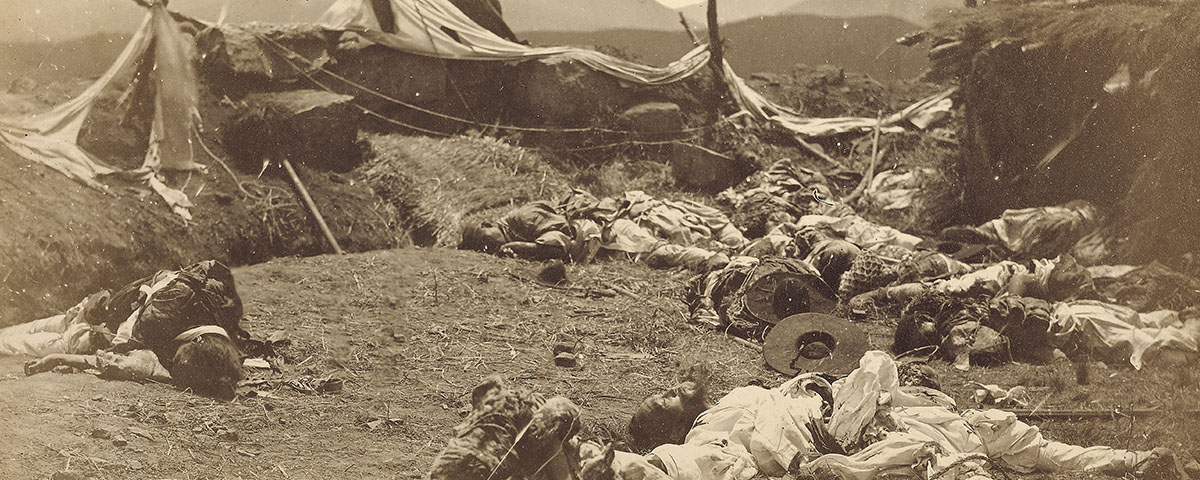Felice Beato took the new art of photography into faraway killing fields and fed his images to a hungry public.
IN THE ANNALS OF EARLY PHOTOGRAPHY, FELICE BEATO STANDS ALONGSIDE such pioneers as Mathew Brady, Roger Fenton, Alexander Gardner, and James Robertson. In a career that spanned the last half of the 19th century, Beato traveled to the Mediterranean, Asia, and Africa in search of the unusual and the picturesque. But in the iconography of war, his photojournalism was groundbreaking—and at times disturbing.
Born in Venice, Beato spent only two years there before his family moved to the Greek island of Corfu, and then to Constantinople. In his 20s he began a close association with the Scottish photographer James Robertson, who had a studio in Constantinople and had married Beato’s sister in 1855. The two men formed Robertson, Beato and Co. and soon were commissioned by P. & D. Colnaghi & Company, a London print company, to replace Roger Fenton as its photographer in the Crimean War.
Though there is no conclusive evidence of Beato’s presence in Crimea in 1855, he probably accompanied his brother-in-law to cover the final months of the war and then helped him develop his panoramic images of various battlefields and of the destruction wrought by the Franco-British bombardment of Sevastopol. In 1856 Beato returned to Crimea alone, and his coverage included several large panoramic scenes, some composed of five or six carefully aligned panels. It was this work that established his reputation as a war photographer in his own right.
WAR PHOTOGRAPHY, AND INDEED PHOTOGRAPHY IN GENERAL, was in its infancy in the mid-1850s. In its earliest decades, in the 1830s and ’40s, the innovative technology was devoted largely to portraiture, with landscapes and cityscapes not far behind; capturing movement was out of the question, because the exposure time for a photographic plate was several minutes. In the late 1840s images from areas of conflict began to appear—scenes of barricades in Parisian streets during the revolution of 1848, the occupation of Mexico City by the victorious American army in the same year.
These static images conveyed little idea of battle, but Fenton and Robertson took war coverage a step further. They captured tableaus of large groups of soldiers on campaign, empty battlefields interrupted only by scattered cannonballs (possibly arranged for effect), and the devastation wrought by heavy bombardment. The work of Fenton and Robertson led Beato to a new realization of the potential of photographic “art”—that it could be an extension of war paintings and sketches, only offering greater clarity and sharpness of detail; that a single image could imply more than it actually showed the viewer, if enough information were included; and, finally, that a dramatic effect could be obtained with the right composition.

By 1858 Beato was in India, dispatched by the British War Department to record scenes from the so-called Sepoy Mutiny. Coming only two years after the Crimean War, this uprising against colonial rule was a shock to the war-weary British nation, especially as it affected both Indian and British non-combatants, with atrocities committed on both sides. The public was eager for images of the besieged towns, and several printmakers offered lithographs and sets of images from such places as Cawnpore and Lucknow, where massacres had occurred. The illustrated press served up a seemingly endless supply of artistic sketches, many based solely on imagination, while academic artists responded with paintings at major exhibitions in London. When Beato was given the war office assignment, he saw an opportunity to make money by supplying real images rather than speculative creations. By January 1858 he was in Calcutta; whether Robertson came as well is unclear, though he was credited with some of the photographs exhibited later that year in England. By the end of March, Beato was in Lucknow, which British forces had recaptured weeks before.
Lucknow had been besieged and relieved twice between September 1857 and March 1858, and on both occasions the Anglo-Indian garrison had had to endure weeks of terrible suffering and deprivations. News of the sieges was telegraphed to Britain, and the public anxiously followed the progress of the relieving columns in the press. By the time the city was finally retaken, its fine civic buildings had been reduced to rubble or disfigured by cannon shot and mines. But to Beato’s keen eye, the scenes of desolation held great potential. Photographs of a pockmarked building could tell a vivid story—a story by association, leaving the horror of what had transpired to the imagination of the viewer. He began to unpack his array of equipment, including a large box camera, the 10-inch-by-12-inch glass plates used to expose images, and the assortment of chemicals needed to process the plates. Making photographs in India presented major obstacles, as the temperature in the tents set up in Lucknow sometimes reached 102 degrees. Yet Beato managed to capture more than 60 images in and around the battered city, including a panorama shot from a mosque balcony and exposed on six collodion wet plates.
Perhaps the most familiar of Beato’s Lucknow photographs—and the most controversial—showed the interior of the Secundra Bagh, a 150-yard-square walled garden on the outskirts of the city. In November 1857 it had been the scene of intense fighting when an Anglo-Indian force made up of the British 93rd Highlanders and the 4th Punjab Infantry Regiment stormed sepoy rebels holding the garden. According to various reports, the highlanders shouted “Remember Cawnpore!” as they slaughtered more than 2,000 Indians in revenge for a massacre that included women and children in Cawnpore earlier in the conflict. After taking Secundra Bagh, the British buried their dead in a deep trench, but the rebel corpses were initially left untouched. Beato took a photograph looking across the garden’s courtyard toward the pillared façade of a somewhat ruined building. Three Indians stand or sit, looking at Beato, while another stands by a horse. Human remains litter the foreground amid rubble, fragments of clothing, and broken window shutters—a scene “strewn with dried corpses and stark skeletons of men that blanch in the sun,” one reviewer wrote on seeing the picture in 1862.
Francis Maude, a captain in the British Army during the conflict, said later that he had seen every one of the fallen men in the garden “being regularly buried, so I presume the dogs dug them up. I saw upwards of 400 swollen but magnificent human bodies in one pit.” In contrast, the noted correspondent of the London Times, William Howard Russell, made a note in his diary on March 12, 1858: “rode over to the Secunderbagh…a large enclosure, with turrets at the angles, and a garden inside with kiosks and summer houses…I walked as far as I could among the skeletons.” By the time Beato arrived on the scene, it seems likely that most of the bones would have been buried, leading to the accusation that Beato “faked” the image by having bones dug up and placed around the ground for maximum visual impact. Another eyewitness corroborated Beato’s manipulation of his scenes. Sir George Campbell had served as judicial commissioner in Lucknow, and in his memoirs, written 35 years later, he remembered the “very horrible” carnage at Shah Najaf, a mausoleum used as another defensive rebel position that had fallen to the Anglo-Indian forces. “The great pile of bodies had been recently covered over before the photographer could take them, but he insisted on having them uncovered to be photographed before they were finally disposed of.”

After shooting the ruined British barracks at Cawnpore, Beato continued on to Delhi and created a similar record of sites and buildings connected with the siege and relief of that city, as well as an eight-piece panorama. While some of his pictures included figures for scale, he did not include portraits among his images, except for a group shot of Lieutenant William Hodson surrounded by some of the native troops from his regiment and a grisly tableau from Lucknow of two hanged sepoy mutineers from the 31st Native Infantry. The onlookers in Beato’s image are all Indian, suggesting to the viewer that the rebels’ hanging was carried out by Indians, not the British.
In February 1859, 26 of Beato’s Lucknow photographs, including the panorama, were exhibited at the Photographic Society of London. His coverage of the mutiny brought his name to the forefront in photographic circles, and a critic for Photographic News called the panorama “one of the most perfect.” Queen Victoria, who had seen a set of the photographs, “was graciously pleased to express her interest in them, they having been the first she had seen,” noted Francis Maude. The Journal of the Photographic Society proclaimed that Beato’s “admirable views give us, in fact, the pictorial romance of this terrible war. They are necessary…to an understanding of the war now, and will be indispensable to its future historians.”
A YEAR LATER BEATO WAS IN CHINA WITH AN ANGLO-FRENCH FORCE sent initially to enforce economic sanctions. He soon found himself in the midst of the Second Opium War, a continuation of the First Opium War of 1839–1842. British insistence on importing opium from India to China led to the conflict, but it had its roots in issues of trade and in Britain’s imperial ambitions. Beato covered the final campaign, recording scenes of the camps, battles, and sieges. His most memorable and graphic images were taken in mid-August at Taku, as European forces captured the outer defenses and then stormed the North Fort. A short time afterward Beato set up his equipment and began photographing the scenes before him, moving in closer and closer. His initial shots were panoramas or distant views of fortified walls and defensive earthworks; he followed these with close-ups of the exterior of the forts and then moved to shots of the human carnage and mass destruction. To many in that era, such scenes would have been too disturbing, but Beato did not shy away from the opportunity to portray the reality of violent death on the battlefield. George Allgood, an eyewitness, wrote to his mother that “Beato, the famous photographer, has got several views of the fort with heaps of dead!” And David Field Rennie, a military surgeon with the British troops, watched Beato in action:
I walked around the ramparts on the west side. They were thickly strewed with dead—in the north-west angle thirteen were lying in one group round a gun. Signor Beato was here in great excitement, characterizing the group as “beautiful,” and begging that it might not be interfered with until perpetuated by his photographic apparatus, which was done a few minutes afterward.
AT FIRST GLANCE, SOME OF THE IMAGES RESEMBLE ROBERTSON’S PHOTOGRAPHS of the interior of ruined fortifications at Sevastopol in 1855, with gabions and fascines, palisades, ladders, and breastworks. But Beato’s images are replete with the dead defenders. When the photographs were exhibited in London in 1862, a reviewer in the Atheneaum noted that the photographs of “the Chinese forts…expand one’s notions of the importance of the difficulties overcome in their capture.”
Beato photographed even more raw images of death in June 1871 while in Korea with an American naval expedition. In his scene of a redoubt at Fort McKee, captured by marines, the faint images of Korean dead can be seen lying close to a ditch. Two other photographs taken within minutes of the storming of the fort show more corpses. Whether his later coverage of the 1885 Anglo-Sudanese war includes images of the dead is unknown, as none of his work from there has survived.
In the two decades that followed, Beato focused his lens more on people and places and less on war. He established a studio in Mandalay, Burma, and produced numerous images of that country before his death in 1909. This later work was a natural progression of his photography elsewhere in Asia, especially his 1860s images from Japan in which he experimented with hand-coloring his photographs.
TODAY BEATO’S SCENES OF THE ARCHITECTURE AND PEOPLES OF EAST ASIA are as well known as his war images. He was no doubt influenced by Robertson and artists like Eugène Delacroix in the composition and arrangement of elements in his images, particularly in the use of foreground props—discarded weapons and other accouterments. But Beato’s images went much further, with dead or dying soldiers in the foreground. It was these gruesome additions that marked him as an innovator, the first photographer willing to show the reality of death and destruction on the battlefield. While his images of corpses and skeletons gained him notoriety, the poignancy and starkness of the ruined buildings in many of his Indian scenes are a documentary tour de force.
Beato left it to his viewers to reach their own imaginative conclusions about the costs of war, but oddly, his images did not necessarily elicit public outrage at the carnage of battle. Instead, they may have inspired or at least reinforced the Victorian belief in British imperial might. His work no doubt set the standard for photographic war reportage for several decades, until the development of moving images changed that reporting forever. Along with Brady and Gardner, Beato broke barriers in his depiction of violence, ushering in an era of photojournalism that now, in the early 21st century, recognizes no boundaries in capturing the brutality of war. MHQ
PETER HARRINGTON is the curator of the Anne S. K. Brown Military Collection at the Brown University Library.
[hr]
This article appears in the Spring 2018 issue (Vol. 30, No. 3) of MHQ—The Quarterly Journal of Military History with the headline: Front Man
Want to have the lavishly illustrated, premium-quality print edition of MHQ delivered directly to you four times a year? Subscribe now at special savings!


